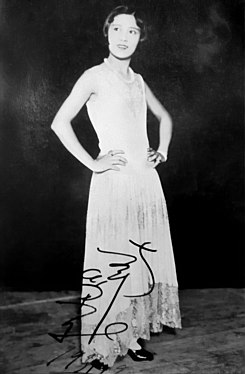Eiko Minami: Difference between revisions
Kjell Knudde (talk | contribs) Added more categories. |
|||
| (11 intermediate revisions by 7 users not shown) | |||
| Line 1: | Line 1: | ||
{{refimprove|date=June 2018}} |
{{Short description|Japanese dancer}}{{refimprove|date=June 2018}} |
||
{{Infobox person |
{{Infobox person |
||
| name = Eiko Minami |
| name = Eiko Minami |
||
| image = File:Eiko Minami 1931 1.jpg |
| image = File:Eiko Minami 1931 1.jpg |
||
| caption = Autographed photo, 1931 |
|||
| birth_name = Sakae Gosha |
| birth_name = Sakae Gosha |
||
| birth_date = {{Birth date|1909|02|20}} |
| birth_date = {{Birth date|1909|02|20}} |
||
| birth_place = [[Hiroshima Prefecture]], [[Japan]] |
| birth_place = [[Onomichi]], [[Hiroshima Prefecture]], [[Japan]] |
||
| death_date = |
| death_date = |
||
| death_place = |
| death_place = |
||
| Line 15: | Line 16: | ||
==Biography== |
==Biography== |
||
Eiko Minami was born {{nihongo|'''Sakae Gosha'''| |
Eiko Minami was born {{nihongo|'''Sakae Gosha'''| |
||
After her film career, Minami taught and choreographed dancers for movies at the [[Nikkatsu]] film studios and also taught dance at Nihon Eiga Haiyū Gakkō, a pre-war acting school founded in 1923 by theater director Biyō Minaguchi ( |
After her film career, Minami taught and choreographed dancers for movies at the [[Nikkatsu]] film studios and also taught dance at Nihon Eiga Haiyū Gakkō, a pre-war acting school founded in 1923 by theater director Biyō Minaguchi ( |
||
==Filmography== |
==Filmography== |
||
* ''[[A Page of Madness]]'' (1926) - Dancer |
* ''[[A Page of Madness]]'' (1926) - Dancer |
||
* ''Tabigeinin'' (1927) |
* ''Tabigeinin'' (1927) |
||
==Gallery== |
|||
<gallery mode="packed" heights="250"> |
|||
File: |
|||
File:Eiko Minami.jpg| |
|||
File:Eiko Minami 1931 2.jpg| |
|||
File:A Page of Madness Still.jpg| |
|||
File:Eiko Minami circa 1930.jpg| |
|||
File:Eiko Minami Shukan Asahi 1933.jpg| |
|||
</gallery> |
|||
==References== |
==References== |
||
| Line 36: | Line 47: | ||
[[Category:Year of death unknown]] |
[[Category:Year of death unknown]] |
||
[[Category:Japanese female dancers]] |
[[Category:Japanese female dancers]] |
||
[[Category:Japanese women choreographers]] |
|||
[[Category:Japanese choreographers]] |
[[Category:Japanese choreographers]] |
||
[[Category:Actors from Hiroshima Prefecture]] |
[[Category:Actors from Hiroshima Prefecture]] |
||
[[Category:20th-century Japanese actresses]] |
[[Category:20th-century Japanese actresses]] |
||
[[Category:Japanese silent film actresses]] |
[[Category:Japanese silent film actresses]] |
||
[[Category:People from Onomichi, Hiroshima]] |
|||
Latest revision as of 22:45, 19 May 2023
This article needs additional citations for verification. (June 2018) |
Eiko Minami | |
|---|---|
 Autographed photo, 1931 | |
| Born | Sakae Gosha February 20, 1909 |
| Occupation(s) | Dancer, actress |
Eiko Minami (
Biography[edit]
Eiko Minami was born Sakae Gosha (
After her film career, Minami taught and choreographed dancers for movies at the Nikkatsu film studios and also taught dance at Nihon Eiga Haiyū Gakkō, a pre-war acting school founded in 1923 by theater director Biyō Minaguchi (
Filmography[edit]
- A Page of Madness (1926) - Dancer
- Tabigeinin (1927)
Gallery[edit]
References[edit]
- ^ Ongaku Nenkan Shōwa 11 Nen ~ 13 Nenban. Dai Nippon Ongaku Kyōkaihen Kyōeki Shōsha.
External links[edit]
- Eiko Minami at the Japanese Movie Database (in Japanese)
- Eiko Minami at IMDb






